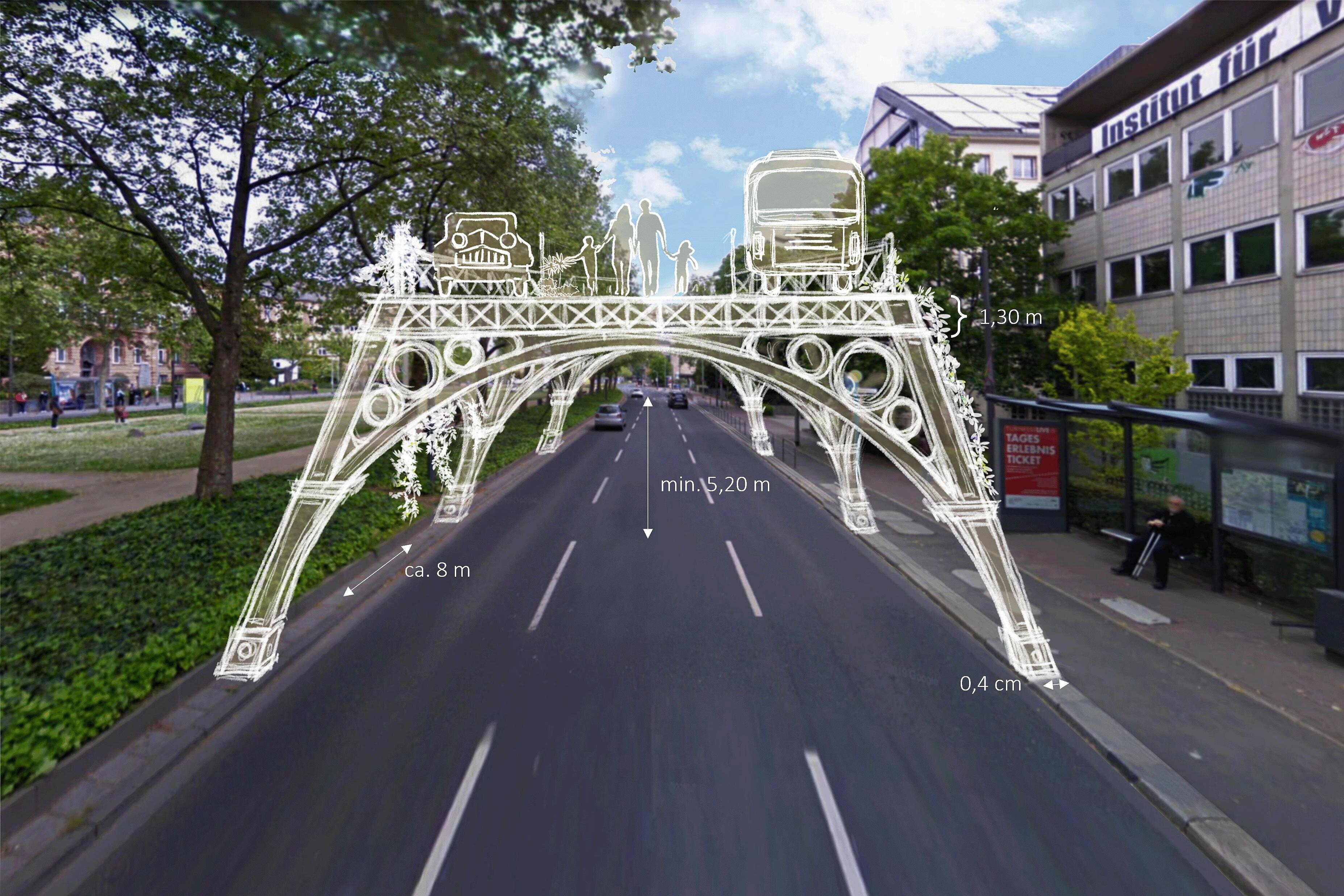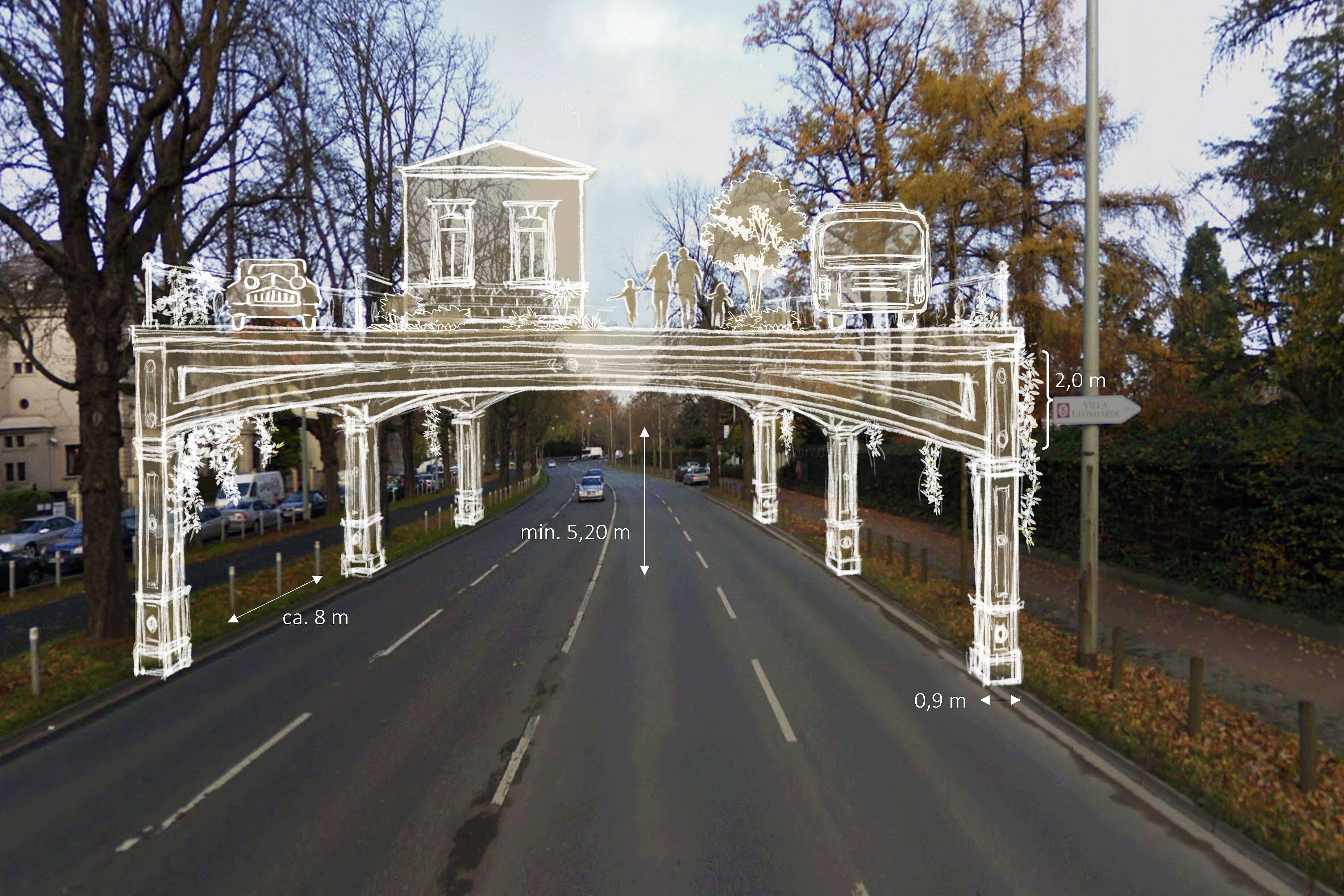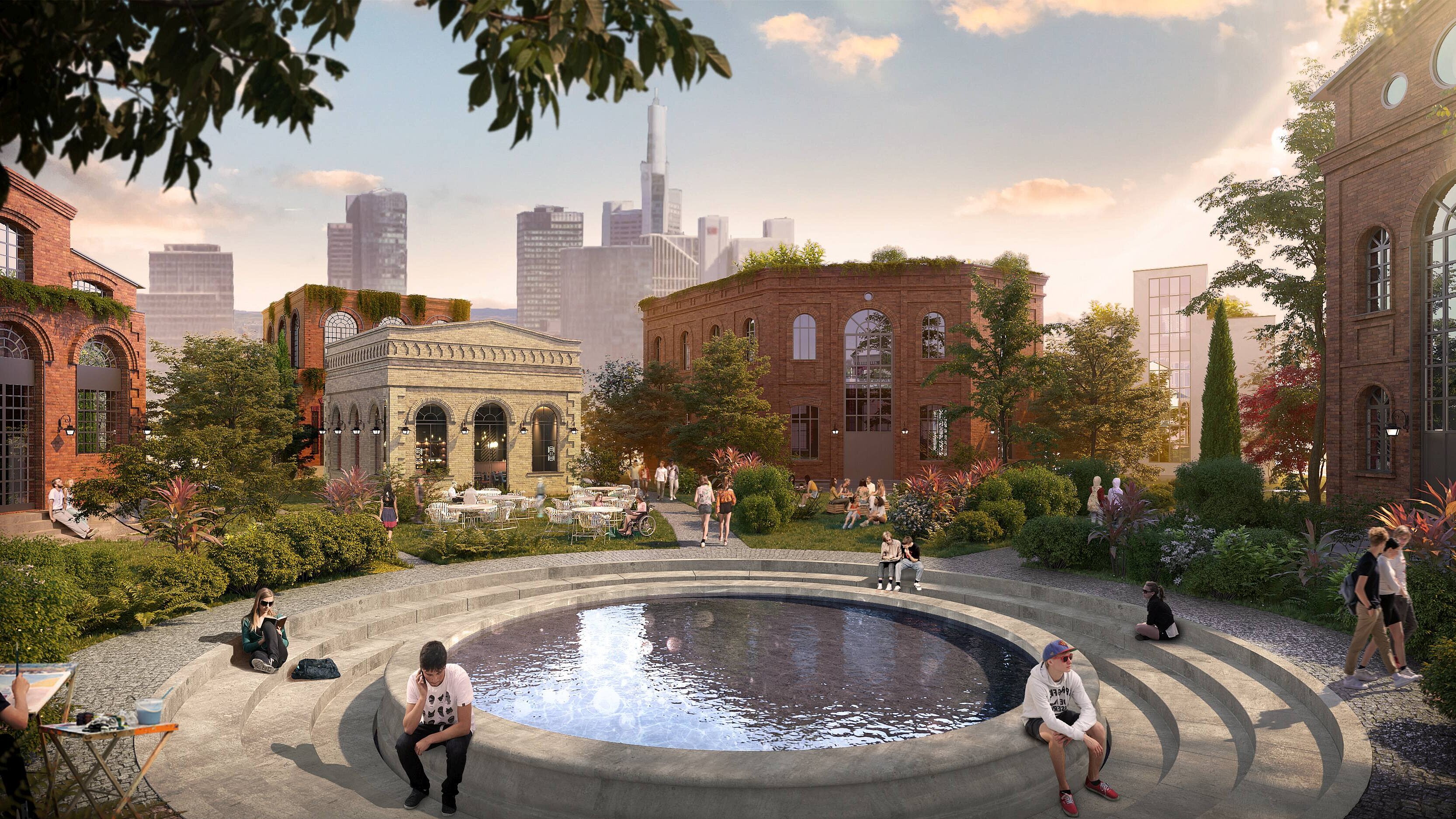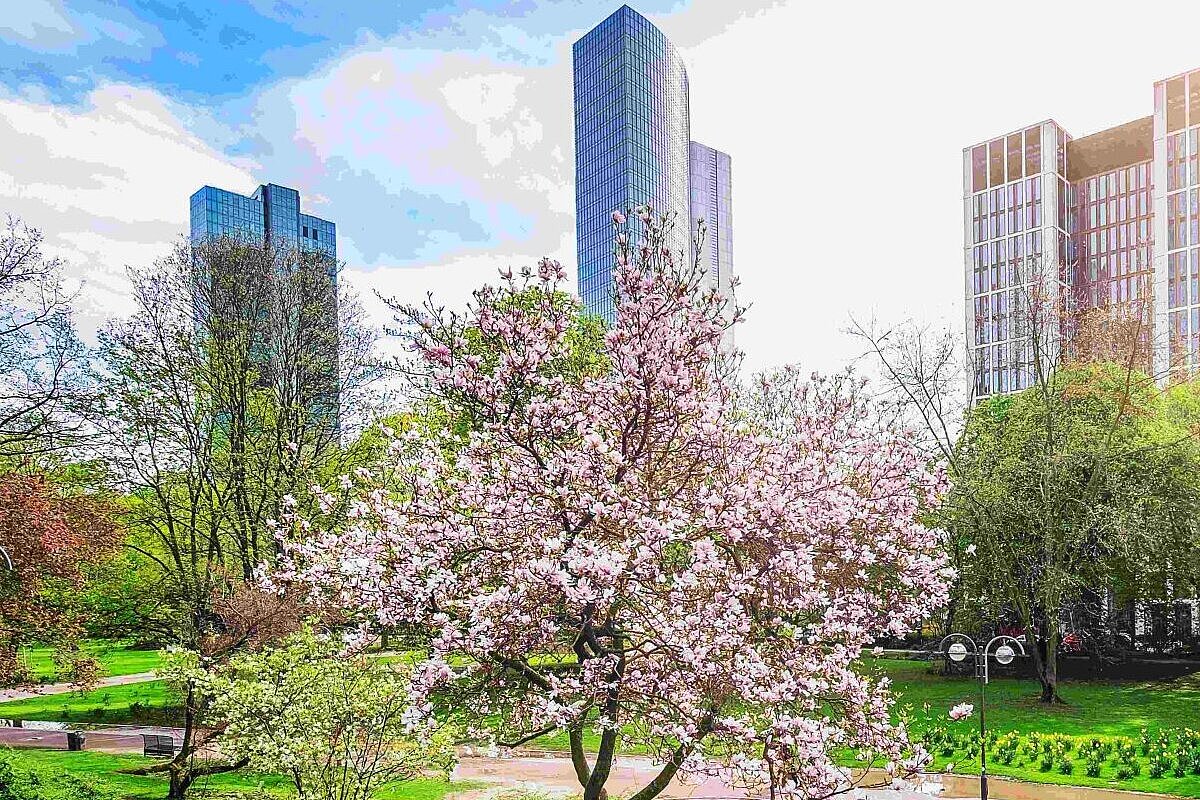The Frankfurt Bridges - a second green level through the middle of the city: buildings with living space for 35,000 people are being constructed on the outer arms, while the ring road connects the outer arms as a traffic artery - with each other and with the city center

In a further step, all parts of the city can be connected and the city can grow sustainably: traffic routes and new housing are built with green concrete without urban sprawl

The bridges are a showcase of innovations on the way to the city of the future: 100% humane and environmentally friendly
They are to create new living environments on a second level in the middle of the city:
green, innovative, sustainable and above all social.
Above gray multi-lane car roads park-like wide bridge areas emerge, hosting beautifully designed affordable housing. This will be framed by landscaped roadways on which autonomously driving traffic will take passengers cleanly, quickly and safely across the city to their destinations.
The bridges are also a new, sustainable second layer of infrastructure in the city: they can collect solar energy and rainwater, distribute it or even transport it to and from storage locations.
Digital lines, hydrogen lines, DC lines, etc. can be laid in the bridges and thus run right through the city without having to tear up the ground. The bridges are another milestone on the road to the infrastructure of the city of the future.
While Life goes on at the top of Frankfurt‘s bridges, traffic continues to flow undisturbed below - and the use of the pavement on either side is retained, as well
An important principle in the planning of the bridges: no tree along the bridge should fall victim to the construction project, no bicycle path, no sidewalk and also no emergency vehicle should be impaired by the bridge columns.


On the bridges, vehicle lanes always run on the outside, walking paths always in the middle
Adapted special solutions are provided for special situations: The bridges can float high above trees, almost like gondolas, or be equipped in sections with an almost continuous glass bod


No tree should have to give way to the Frankfurt bridges infrastructure project: Where there are old trees, the bridge section runs over the treetops - with glass inserts in the ground. On narrower roads, almost the entire bridge corpus is made of high-strength trafficable glass, so that it also remains very light under the bridges.
The space under the bridges is bright - light holes in the bridge floor are partly covered with walkable glass, partly open with guardrail protection

At critical bottlenecks, the bridge is to be designed using high-strength glass that is opaque when ground, but allows daylight and sunlight to pass through almost completely.A similarly polished screen protects the privacy of the adjacent houses - and for noise protection, the sides of the bridge between the piers could even be partially glazed down to the ground.


Apart from this fundamental structure, the bridges are colorful and varied, with no two sections being alike.


Not only are they aesthetically varied, but distinguished areas, suited for a wide variety of groups, can be created on them: Living spaces, natural experiences, meeting places, art and culture -to participate in or enjoy-, working environments, sports opportunities, spaces for playing, and much more.


The urban energy transition - also in the existing building stock

The green „Water-Wise City" of the future

Emission-free autonomous driving

Affordable housing in the city center
![[Translate to English:] @](/fileadmin/_processed_/f/9/csm_A_Lantern_Place_Day_2bf0dcd381.jpg)
All of this can be realized in one exemplary neighborhood: the new beautiful and modern city quarters – which are not somewhere in a greenfield, but on bridges in the middle of the city.
Thus, the realization takes place on an independent second level, but is also integrated into existing city life.
This second level is green, restful, artistic, aesthetically pleasing and full of innovations.
The solutions take place in the middle of the city - in the middle of life - in the middle of the existing infrastructure: Surrounding areas aren‘t overdeveloped, no satellite towns are created
Connections are created, where there were none before
Areas of the city previously dissected by large driveways are now connected. Outlying districts can be connected directly to the city center.
The goal: no one loses! Everyone should be happy about the bridges
Everyone should benefit from the bridges: Children and seniors, parents and singles, the financial world and the homeless, craftsmen, industry, direct bridge residents as well as rest of the city's inhabitants, cyclists and car drivers – everyone should feel an improvement.
The new is integrated into the old - without destroying the old!
From our cultural roots, the best and most beautiful is taken up and combined with the most modern technology: tradition and innovation not as opposites, but as complements - on the way to the city of the future!
![[Translate to English:] Jan-Philipp Thiele - unsplash.com](/fileadmin/_processed_/0/2/csm_Frankfurt_0_Jan-Philipp_Thiele_-_unsplash.com_bc65a2a129.jpg)
In short: Frankfurt bridges have many functions
1.They carry a complete newly created urban area with 1.15 million square meters of building space
2.They are a transport network link that creates new direct connections into the city center.
3.They provide a photovoltaic and solar thermal surface
4.They serve as a distribution structure for collected rainwater, energy, hydrogen and digital lines
5.For solar energy generated above ground, their 15,000 columns are an infrastructure that transports the energy into geothermal ground storage and back up when needed
6.With one million square meters of green, unsealed surfaces on their bridge bodies, they provide a planted "park network" over asphalted, sealed car-driven areas in the city
Not forgetting the most important goal: Beyond the ingenious features, the Bridges must be designed to be appealing to humans, which means they must be bright, artistic and above all as green as possible. Every person who reaches the bridges should feel a sense of joy and relief, similar to arriving at a beautiful park after a long walk through the city, where there is a lake, a playground, benches, refreshment pavilions, fountains, etc., and a variety of relaxing corners and paths.
You can download the complete THE PLAN topic page here as a PDF presentation -THE PLAN
Implementation planning must be based on innovative but viable financial and legal concepts
Only with the appropriate legal and financial preliminary planning can the implementation be people-friendly, nature-friendly and within budget. This infrastructure project is being implemented on a non-partisan basis in the interests of all citizens or all people whose lives will be even more interwoven in the future as a result of globalization. Accordingly, the Frankfurt bridges are an infrastructure project for Germany, for Europe and for the world.Financing is planned as crowd-funding by major German and European corporations. For the first 100 years from the start of planning, the Frankfurt bridges will be at the service of society, i.e. for affordable housing, culture, education and, above all, research and science. The bridge infrastructure will be donated to the city of Frankfurt after completion, but the bridge surface with its buildings, gardens and vehicles etc. will only pass to the investors after 100 years. Before that, there will be no amortization payment, but all revenues of the non-profit operating bridge company will go back into the maintenance of the bridges, the upkeep of their green spaces, the cultural and educational program, etc. The shares in the investors' fund to be established are fungible, tradable tax-free. Similar to a bond, the intrinsic value increases from year to year as the date of transfer of ownership to the owners approaches.
![[Translate to English:] Frank Rumpenhorst dpa picture alliance](/fileadmin/_processed_/1/0/csm_teaser1_cec0e5f920.jpg)
![[Translate to English:] Karl Hendon - gettyimages.com](/fileadmin/_processed_/3/8/csm_Karl_Hendon_-_gettyimages.com_75a0565933.jpg)
![[Translate to English:] markus spiske - unsplash.com](/fileadmin/_processed_/b/a/csm_4_markus-spiske-BmijTSQq27c-unsplash_300dpi_0ddbef8baf.jpg)
![[Translate to English:] Stiftung Altes Neuland Frankfurt GNU](/fileadmin/_processed_/f/3/csm_PDR_2022-01-13_CAM_1_59f942329f.jpg)